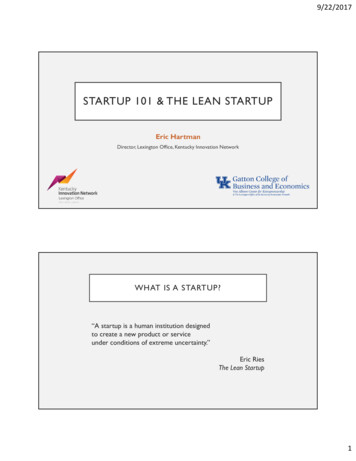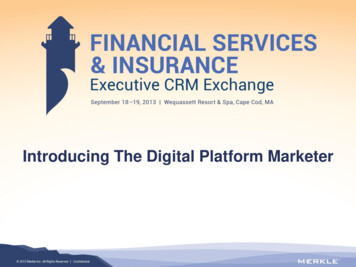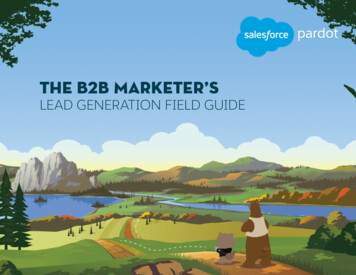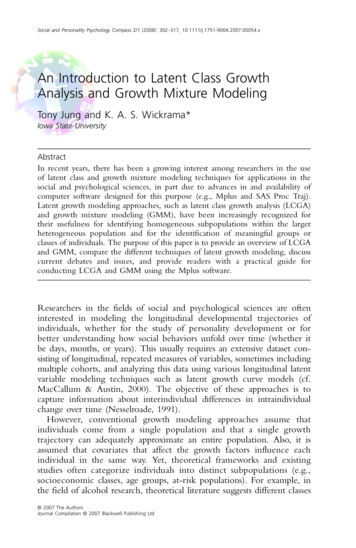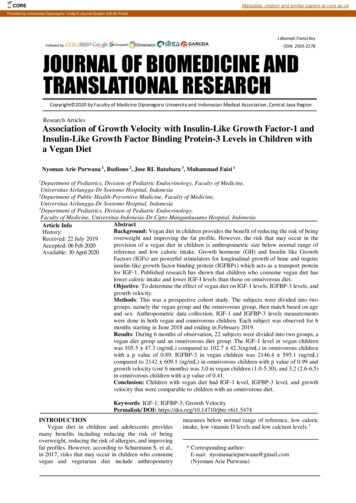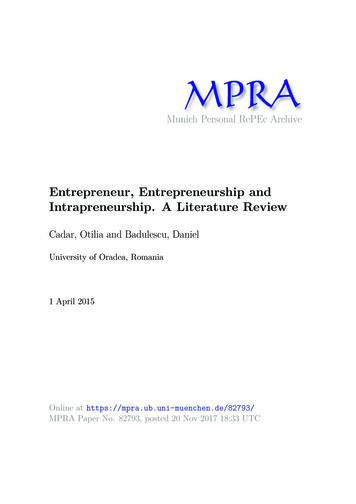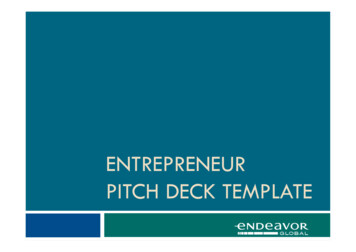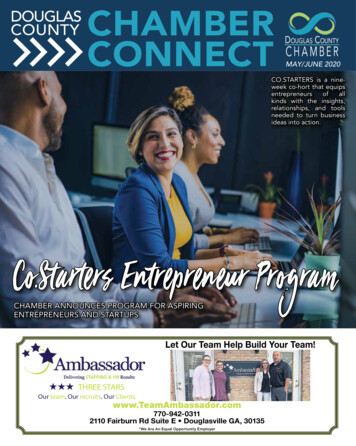
Transcription
STARTUP GROWTHRESOURCES CHEAT SHEET
CONTENTS.01 STARTUP GLOSSARY02 BLOGS03 RESOURCE LIBRARY2
Startup Glossary.Curious about some of the startup and growth hacking terminology commonlyused? Refer to the glossary below for definitions to these key phrases.General Phrases Growth Hacking – Coined in 2010 by Sean Ellis, growth hacking uses acombination of creativity, analytical thinking, experimentation and metrics trackingto sell products, gain exposure and encourage rapid growth within a company.Dropbox and AirBNB are two companies that have popularized the use of growthhacking techniques. Analytics – Analytics is a broad term encompassing all of the different metrics astartup might track, as well as the programs that provide this data. GoogleAnalytics is a popular free program that many entrepreneurs use to generatemetrics data. Conversion Rate Optimization (CRO) – CRO refers to the process of makingchanges to a website or landing page with the goal of increasing the number ofonline visitors that take a specific conversion action (for example, completing alead generation form or purchasing a product). Split Testing – The two types of split testing – A/B split testing and multivariatetesting – involve conducting controlled, randomized website tests that presentwebsite visitors with different combinations of text and images in order to uncoverthe winning combination that improves a specific website metric. For example, awebsite using A/B split testing might randomly deploy two versions of a landingpage with different headlines to see which contributes to more purchases.3
Startup Glossary. Call-to-Action (CTA) – A call-to-action is a piece of text or an image that exhortsvisitors to take a specific action. A “Buy Now’ button is a CTA, as is a closingparagraph to a blog post that reads, “Take advantage of this special offer now bycompleting the form below.” Pivot – According to Steve Blank, a pivot is a fundamental change in a business’scustomer segment, channel, revenue model/pricing, resources, activities, costs,partners or customer acquisition strategy. Pivots occur when untested businesshypotheses are disproven, requiring a change in one or more elementsunderpinning these assumptions. Product/Market Fit – Essentially, product/market fit refers to the extent towhich a given product satisfies a market demand. An improved fishing pole has agood product/market fit with fisherman, while a new set of work gloves does not. Software as a Service (SaaS) – SaaS is the name given to software productsthat are centrally hosted by a vendor and made available to customers over theinternet. Dropbox, Quickbooks, Microsoft Office 365 and Adobe Creative Cloud areall popular examples of SaaS programs. Disruption – Though the term has become a bit overused, a “disruptive” productis one that challenges traditions in an existing market. A product that offers asignificantly different pricing model, appeals to a new set of target customers ordisplaces older technology can be considered disruptive.4
Startup Glossary.Metrics Terminology Key Performance Indicators (KPIs) – KPIs are a set of metrics that abusiness tracks to assess its ongoing performance. A startup may track one KPIor 20, but what’s important is that the selected metrics provide an overall picture ofthe startup’s health and viability. One Metric That Matters (OMTM) – As an alternative to a set of KPIs, somegrowth hackers prefer to focus on “one metric that matters.” This OMTM might beany of the metrics listed below, or it could be any other data point that provides anoverall snapshot of the business’s progress. Churn Rate – Churn rate refers to the percentage of customers that stopsubscribing to a service. If your business involves a free trial or a month-to-monthsubscription, your churn rate would be the percentage of prospects that fall out ofyour trial period without subscribing, or the percentage of customers that canceltheir paid subscriptions during any given month. Customer Acquisition Cost (CAC) – Depending on the complexity of thecalculation, CAC can include everything from paid ad spends to the overhead costsaccrued during the time it takes a lead to go from prospect to customer. CAC isbest used when compared to LTV to ensure that the startup isn’t spending more toget new customers than it’s receiving in revenue from new users. Lifetime Value of Customer (LTV) – LTV involves the net profit a singlecustomer can be expected to contribute to a business throughout his or herlifetime. If, for example, your startup sells a monthly subscription at 300/month,your average customer cancels after 27 months and you have a CAC of 1,450 pernew user, your LTV would be 6,650.5
Startup Glossary. Average Order Volume (AOV) – Another metric that some startups use tomeasure progress is the average size of each order that goes out. If your AOV was 100 in October 2013 and 200 in October 2014, this could indicate that yourbusiness’s performance is improving. Monthly Recurring Revenue (MRR) – MRR – or, the amount of recurringrevenue a business generates month over month – is a metric that’s popular withSean Ellis, Hiten Shah and other well-known growth hackers. Points in this metric’sfavor include its ability to take new business, churn, upgrades and downgradesinto effect, as well as its compounding nature. Net Promoter Score (NPS) – A less commonly used growth metric is abusiness’s NPS, which is a score falling between -100 and 100 that measurescustomers’ willingness to recommend a company to others. This score can behelpful in detecting changes in consumer sentiment, but does not always directlytie to revenue or growth. Daily Active Users (DAU)/Monthly Active Users (MAU) – DAU and MAUmeasure the “stickiness” of an internet product by determining the number ofusers that visit during a given day or month. When DAU or MAU metrics aretrending upwards, it can be assumed that the product is gaining traction among itstarget user base. AARRR – “AARRR” is a startup metrics model that incorporates five key datapoints: acquisition, activation, retention, referrals and revenue. Focusing on all fiveis more complex than tracking a single OMTM, but can give a more comprehensivelook at a business’s health.6
Startup Glossary.Fundraising Phrasing Angel investor – An angel investor is a single person who offers capital to astartup in exchange for an equity/ownership stake. Angel investment is usuallysought and offered early in a startup’s life and typically precedes seed roundfundraising. Burn rate – Burn rate refers to the speed at which an entrepreneur or startupspends its money. As an example, if Startup A earns a 500,000 fundraising roundand spends an average of 10,000/month on everything from paid ads topaperclips, its 10,000/month burn rate gives it approximately 50 months ofcapital. Due diligence – Before an investor contributes capital to a company, the “duediligence” process occurs, during which investors analyze the startup’s currentfinancial situation and future potential. This detailed analysis helps investorsestimate the ROI they might receive on their contributions. Seed round – A seed round is typically the first fundraising round a startup willpursue. Funds from these efforts are often used to prove a concept or build aprototype, rather than fuel an existing product line’s expansion. Venture capital – Venture capital is money that comes from venture capitalists(VCs), who may be individual investors or firms that invest in particular markets orsectors. Venture capital is typically provided to companies with high growthpotential in exchange for equity/ownership stakes. Fundraising rounds – Capital fundraising efforts made by startups are typicallylabeled as follows: Seed, Series A, Series B and Series C. Further alphabeticallylabeled rounds may be carried out, though investors must be certain that potentialprofit still remains based on the equity already given out and the product’slikelihood of significant market success.7
Blogs.Want to put your newly-learned startup lingo to work? Add these 20 blogs toyour RSS feed reader and check in regularly for insight from top entrepreneurs:1. Sean EllisInsight from the man who coined the phrase“growth hacking”2. Both Sides of the TableA great all-around startup blog based on theexperiences of VC Mark Suster3. Startup Lessons LearnedSelf-explanatory blog by Eric Ries, author of the book The Lean Startup4. Work AwesomeTips on working and living better forentrepreneurs and startups at all stagesof growth8
Blogs.5. OnStartupsA self-described “site for entrepreneurs,”including discussions, resource articles andmore6. Seth GodinThe godfather of modern marketing techniques7. Tomasz TunguzA venture capitalist who writes on topics of interest to entrepreneurs8. Matt CuttsGet updates on SEO straight from the mouth of Google’s web spam teamleader9. Rand FishkinMore great SEO wisdom comes from Rand Fishkin,founder of Moz10. 500 StartupsLessons learned from a team of 500 startup founders, mentorsand investors9
Blogs.11. Avinash KaushikThe web’s go-to expert for all things analytics12. Noah KaganGreat blog posts on marketing, startups, life hacks andmore from the founder of AppSumo and Okdork13. Jason Cohen“Startups marketing geekery” from JasonCohen, founder of WP Engine and Smart BearSoftware14. Adam NashTips and tricks from a former LinkedIn executive who blogs on everythingfrom personal finance to growth hacking15. Nabeel HyattStartup lessons from a former Zynga exec, now working as a VC16. Chamath PalihapitiyaGrowth hacking tips from a former growth lead at Facebook10
Blogs.17. Jeremy LiewBlogging on growth topics since 2006, Jeremy isone of the web’s best sources of startup advice18. Andrew ChenEssays on startups, marketing and user growth written by formerentrepreneur-in-residence and current advisor/investor Andrew Chen19. Alex PayneOften-controversial, always-uncensored insight from VC Alex Payne onbusiness, technology and living life in general20. Tim FerrissTips on hacking your business, mind and body from the man who broughtthe idea of hacking to our collective consciousnessAnd of course, I’d be remiss if I didn’t mention my cousin Neil Patel’s blogs atQuickSprout and KISSMetrics. Check them out for cutting-edge insight oneverything from copywriting to analytics and more.11
Resource Library.The following resource library is grouped chronologically by the differentstages every startup goes through.How to Get Started Buffer Social – “Idea to Paying Customers in 7 Weeks: How We Did It” Entrepreneur – “How to Start a Business in 10 Days” The Muse – “You Have an Idea – Now What? 3 First Steps for YourStartup” Tomasz Tunguz – “The 3 Minute Technique for Brainstorming YourStartup’s Product Roadmap” Healthpreneur – “How to Start An Online Business” Perception IT – “Ultimate Ecommerce Guide for Online Entrepreneurs” Entrepreneurship in a Box – “50 Questions to Develop Business Idea” Chron – “7 Steps of Product Development” Visual.ly – “10 Rules to a Great Startup Idea”12
Resource Library.Validating Your Idea Usability Hour – “How to Validate Your Ideas for Free With This Landing Page” Hatchery – “How to Validate Your Business Idea By Testing a Hypothesis” Growth Hackers – “7 Steps to Validate Your Startup Idea”Getting Your Initial Customers Optimizing Rocks – “If You Build It It’s Just There” Moz – “How to Grow: 21 Tactics to Acquire Customers” Growth Hackers – “19 Ways Growth Hackers Acquire Customers” Medium – “The Growth Hacker’s Cookbook”Customer Retention Conversion XL – “9 Case Studies That’ll Help You Reduce SaaS Churn” KISSMetrics – “How Mention Reduced Churn by 22% in One Month” The Next Web – “Creating Customers for Life: 50 Resources on Loyalty, Churn andCustomer Retention” Tomasz Tunguz – “Why Everything I Thought I Knew About Churn is Wrong”13
Resource Library.Measuring Your Performance Infinite Conversions – “Conversion Rates Don’t Really Matter: Here’s 8Reasons” Growth Hackers – “What’s the Best Way to Measure Relationship BetweenConversion Rates and Testing?” Paddle – “6 Tools We Use to Grow Our Startup” Twoodo – “A Huge Epic List of Growth Hacking Tools for Non-Coders”Core Metrics for Startups Clarity – “Measuring the Health of Your SaaS Business: the Ultimate Metrics Guide” Growth Hackers – “The Only Metric That Matters” KISSMetrics – “How to Calculate Lifetime Value – The Infographic” Roy Povarchik – “7 Metrics Every Ecommerce Marketer Should Follow to AchieveGrowth”14
Resource Library.Conversion Rate Optimization Conversion XL – “Unlocking Your Company’s Growth Engine with ConversionRate Optimization” Conversioner – “How and Where to Start Optimizing to Increase Your Conversion” Conversioner – “10 Psychological Triggers to Boost Revenues” Perception IT – “Some Minor Changes Can Give Big Increment in ConversionRates” Userlike – “8 Sure-Fire Ways to Skyrocket Your eCommerce Conversion Rates”Growth Hacking Experiments Rob Sobers – “Growth Hacking Trello Template” The Agency Post – “The 50/50 Experiment: A New Technique for Growth Hacking” Growth Hackers – “How Do You Capture and Manage Your Ideas for GrowthHacking Experiments” Referral SaaSquatch – “Building a Process for Growth Experiments”15
Resource Library.SEO for Startups Startup Bloggers – “5 Effective SEO Tactics That Won’t Cost Your Startup aDime” Medium – “SEO Checklist for Startups: 10 Essential SEO Tips/Tricks for YourNew Website” Forbes – “7 Ways That SEO Is Uniquely Important for Entrepreneurs” Giankar – “Video SEO: The Only Guide You Need” Bloggers Ideas – “Top 15 On-Page SEO Tools to Optimize Your Site” ePoint Digital – “22 Local SEO Tips and Tricks for Small Businesses” Synup – “30 Common Local SEO Problems & How to Fix Them”Content Marketing Search Engine Journal – “Content Marketing Tips for Launching a New Product:Interview with Guy Kawasaki” Unbounce – “9 Content Marketing Growth Hacks to Drive Traffic and Conversions” Jeff Bullas – “21 Content Marketing Lessons from the New York Times” Heavybit Industries – “Interview: Hubspot’s VP Content on Developer ContentMarketing” Built Visible – “Content Development: Finding Great Topics for Your Target Audience” McMurry/TMG – “This is Your Brain on Content Marketing” Small Business Trends – “10 Content Marketing Tips from Our Community”16
Resource Library.Raising Money Marketer Graham – “Fundraising Marketing: Hacks for Raising Your Round” Seedcamp – “Setting Appropriate Milestones in an Early-Stage Startup” Clarity – “Then & Now: Youngest Person to Raise VC Shares His Growth Path” AdEspresso – “Want 1M? Here’s How We Did – Anatomy of An AngelListFundraising” Blonde2.0 Blog – “How We Helped Raise 75,000 for an Indiegogo Campaign– Step-by-Step” Rocketship.fm – “Growth, Pricing and the Realities of Funding” Squirrly – “Funding Your Startup is Now a Piece of Cake” Enamtila – “How to Succeed in Crowdfunding & Achieve 1090% Funding Goal” Jay Gould – “Value is What You Create – Price is What You Get”Building a Team Entrepreneur – “5 Steps for Building a Great Startup Team” Step Consulting – “Wanting the A-Team is One Thing. Getting It IsAnother” Social Media Today – “How to Assemble a Content Marketing Team forYour Blog” Tomasz Tunguz – “Startup Best Practices #9 – Structuring One on OnesTo Maximize Your Team’s Success”17
Resource Library.Partnership Considerations Ramon Bez – “Driving User Growth Through High Profile Partnerships” Entrepreneur – “How to Successfully Collaborate with a Larger Business Partner” Vero – “How to Growth Hack Using Partnerships: An Online Marketing Strategy” Perception IT – “Major Things to Know About Entry-Level Business Development &Partnerships”Legal Advice for Entrepreneurs Inc. – “14 Legal Tips for Starting Up” LexisNexis – “How Much Should a Startup Pay in Legal Fees?” Inc. – “4 Online Legal Resources that Limit Your Startup’s Need for an Attorney” Forbes – “Startups That Seek Legal Advice Early Can Avoid ‘Soul-Crushing’ Mistakes”Personal & Business Productivity Quora – “As a Startup CEO, What Is Your Favorite Productivity Hack?” Kyle Van Pelt – “This Experiment Could Change My Life Forever” The Payroll Blog – “22 Powerful Productivity Hacks for SmallBusinesses” MyCrowd – “Top 10 Productivity Hacks for Startups”18
Resource Library.Tools & Resources Growth Hackers – “What are Your Go-To Task Management Productivity Tools?” Siege Media – “750 Popular Subreddits Categorized by Industry and SubmissionType” Soundest – “Ultimate List of 99 Email Marketing Resources” Autosend – “13 Marketing Tools for Data-Driven Marketers” Leadin – “Top 3 WordPress Keyword Research Plugins” Conversion XL – “10 Google Analytics Reports That Tell You Where Your Site isLeaking Money”19
For more ways to increase your traffic andgrow your business check out our books:20
A great all-around startup blog based on the experiences of VC Mark Suster Want to put your newly-learned startup lingo to work? Add these 20 blogs to your RSS feed reader and check in regularly for insight from top entrepreneurs: 1. Sean Ellis 2. Both Sides of the Table Self-explanatory blog by Eric R
